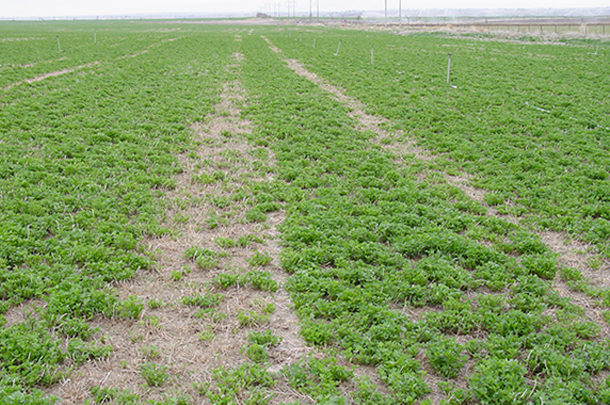Alfalfa is less susceptible to mechanical and chemical injury when it is dormant, but when is that? We have been working with growing degree days to estimate breaking dormancy, but whenever I think I have it figured out, Mother Nature throws me a curve. The reality is individual plant parts and tillers become dormant at different rates, and the plants never completely stop physiological activity. In addition, there remains a lot of variability between plants because alfalfa varieties are synthetic populations and tetraploid with much natural variation, and spring growth is not highly related to fall dormancy rating.
We can also set up our alfalfa fields for injury and stand loss by sending our fields into winter with poor carbohydrate reserves. The carbohydrate reserve status from fall is a big factor in stand persistence and spring vigor. Generally, cutting in mid- to late-September is the most dangerous time for stand persistence because the carbohydrates are unlikely to be replenished before dormancy or killing frost.
Notwithstanding, fertilizer, dormant herbicides and pesticides should be applied when the alfalfa is truly dormant. The window for operating in dormant alfalfa fields may actually be pretty small.
Mechanical injury to the plants can be an issue. Fertilizer or herbicide applications over snow, even with high floatation equipment, can compress snow into ice, which can kill or injure plants far into the next season, leaving permanent tracks. I have seen permanent wheel tracks from a December fertilizer application on a snow-covered alfalfa field. Soft ground, mud or frozen crowns are all good reasons to avoid operating equipment in alfalfa fields. However, in some cases, waiting for conditions to improve may delay herbicide applications so that it injuries the alfalfa.
Alfalfa herbicide selectivity is usually derived either by physiological resistance of the plant or more commonly by incorporating the material in the soil surface before the alfalfa roots become active. Several herbicides can help control winter annual grasses and weeds in established alfalfa. Determining establishment status should be done with a shovel to check root size and depth. Root diameter should be larger than a pencil. Read and follow the label.
Metribuzin, Velpar, Sinbar, Pursuit, Raptor and Karmex are available for dormant application, but check the label before using in your state, on your soil and environmental conditions. All these herbicides control mustards and pennycress, but Karmex and Pursuit do not control downy brome (cheatgrass) very well. The herbicides need soil moisture to be incorporated and activated. Applying herbicides to frozen soil may result in their off-site movement during the thaw or a rain on frozen ground.
More often problems occur when the herbicide is applied too late or when incorporation with rainfall or irrigation is delayed until the alfalfa is coming out of dormancy. Visual damage is often chlorosis of the alfalfa leaves, or yellowing, and production is delayed or curtailed. For the above reasons, I prefer to apply dormant applications in November to December if soil moisture is not excessive.
I don’t recommend applying manure on alfalfa, but in some cases, it may be necessary to meet nutrient management plans. Care should be taken to avoid conditions where runoff from manure application sites can impact water sources. Dormant applications for compost are recommended and preferred over manure applications on alfalfa. Compost will be readily moved to the soil surface and will be incorporated into the soil microbial cycles. Manure can cause problems, usually an over-application issue, by covering spring buds and delaying their development.
For organic growers or producers who like to use tillage for weed control or leveling rodent mounds, it is also best done in the dormant season. Tillage in the fall to control the winter annuals is more effective than spring tillage. The mustards and other winter annuals are often too well established by March for light tillage to take them out. I don’t recommend tillage as a common practice in non-organic alfalfa.
Most winter annual weeds such as mustards and grassy weeds are best controlled when the weeds are tiny. Spring tillage and wheel tracks will cause some plant damage and open paths for plant diseases to get started. Waiting until March is usually not very effective for winter annual weed control and might be called “recreational tillage.” The need for recreational tillage occurs when a farmer can no longer stand to stay off his “big iron,” regardless of the lack of benefits over costs.
The best window for dormant application may be a brief period. It usually is abruptly shut by a fall or winter storm, or may be open for a very short time in the spring, so plan your dormant work carefully and be prepared to go when environmental conditions are right. FG
Glenn Shewmaker is a forage specialist with the University of Idaho.
PHOTO: This field of sandy soil shows the effects of floater fertilizer applied when snow was on the ground in December of the previous year. Photo by Glenn Shewmaker.












